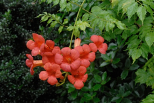Trumpets for a Garden Symphony
go.ncsu.edu/readext?784711
en Español / em Português
El inglés es el idioma de control de esta página. En la medida en que haya algún conflicto entre la traducción al inglés y la traducción, el inglés prevalece.
Al hacer clic en el enlace de traducción se activa un servicio de traducción gratuito para convertir la página al español. Al igual que con cualquier traducción por Internet, la conversión no es sensible al contexto y puede que no traduzca el texto en su significado original. NC State Extension no garantiza la exactitud del texto traducido. Por favor, tenga en cuenta que algunas aplicaciones y/o servicios pueden no funcionar como se espera cuando se traducen.
Português
Inglês é o idioma de controle desta página. Na medida que haja algum conflito entre o texto original em Inglês e a tradução, o Inglês prevalece.
Ao clicar no link de tradução, um serviço gratuito de tradução será ativado para converter a página para o Português. Como em qualquer tradução pela internet, a conversão não é sensivel ao contexto e pode não ocorrer a tradução para o significado orginal. O serviço de Extensão da Carolina do Norte (NC State Extension) não garante a exatidão do texto traduzido. Por favor, observe que algumas funções ou serviços podem não funcionar como esperado após a tradução.
English
English is the controlling language of this page. To the extent there is any conflict between the English text and the translation, English controls.
Clicking on the translation link activates a free translation service to convert the page to Spanish. As with any Internet translation, the conversion is not context-sensitive and may not translate the text to its original meaning. NC State Extension does not guarantee the accuracy of the translated text. Please note that some applications and/or services may not function as expected when translated.
Collapse ▲Trumpets play high brassy and brilliant notes through about 4 ½ feet of tubing. From Greek and Roman military marches to European royalty celebrations to modern jazz, trumpets are known for fanfare, prestige, and flare. Trumpets fit right into the floral symphony of a beautiful garden with many different kinds to choose from. From Angel’s Trumpet to Trumpet vine to Trumpet Creeper Vine, and many other tubular-shaped flowers, there is much to love and some to be wary of.
 1 ‘Crimson Trumpet’ Flower by Jim Robbins CC BY-NC-ND 4.0
1 ‘Crimson Trumpet’ Flower by Jim Robbins CC BY-NC-ND 4.0
Trumpet creeper vine (Campsis radicans) often gets confused with Trumpet Vine (Campsis grandiflora). You will want to know the difference. Hint: Trumpet Creeper Vine also carries the common names of Devil’s Shoestring, Cow-itch, and Hellvine to name a few. A very common plant that is native to the southeastern US it can be found in swamps, forests, and thickets and has naturalized its way into many northern states too. This plant boasts stunning orange-red trumpet flowers in the summer from dense, multi-stemmed, woody, clinging vines. These vines latch onto structures and trees, climbing up by aerial rootlets while also spreading out by prodigious underground runners as well as seeding themselves around. While the leaves will grow well in shade, the blooms need the sun.
If you like to have hummingbirds visit your garden, can supply a strong arbor or trellis support for the vine and stay after pruning its advance (and mowing over the suckers and unwanted sprouts) then this vine’s rapid growth makes training it easy. If you decide to try it, select a site that isn’t right next to the house because it can force its way between wooden house siding and destroy it. This plant also has an extreme flammability rating and should not be planted within the defensible space of your home.
The other Trumpet vines (Campsis grandiflora) and (Campsis x tagliabuana) aren’t such garden bullies. With less robust aerial roots, these deciduous climbing vines sport large, deep orange to red flowers, July to frost. Look for them to be soil and salt tolerant with a fast growth rate and no serious pest-disease problems.
To read more about the Trumpet Creeper Vine and its relatives take a look at the NC Extension Gardener Plant Toolbox information found here: Campsis Radicans. While you’re there, check out some of the over 4000 species cataloged in the database for plants that may work well under your site’s conditions.
Minda Daughtry is the Horticulture Agent for North Carolina Cooperative Extension in Lee County.




